
Stag beetles are a family of about 1,200 species of beetles in the family Lucanidae, currently classified in four subfamilies. Some species grow to over 12 centimetres, but most to about 5 cm (2 in).

The tansy beetle is a species of leaf beetle. It measures 7.7–10.5 mm in length and has a characteristic bright metallic green colouration. The common name derives from the tansy plant on which they often feed as both larvae and adults. In addition to the nominotypical subspecies, which repeats the specific name, C. graminis graminis, there are five further distinct subspecies of tansy beetle, which, collectively, have a Palearctic distribution, although in the majority of countries where it is found the species is declining. In the United Kingdom it is designated as 'Nationally Rare' and this localised population, centred on York, North Yorkshire, has been the subject of much recent research.
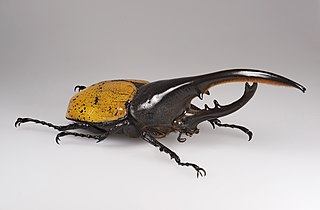
The Hercules beetle is a species of rhinoceros beetle native to the rainforests of Central America, South America, and the Lesser Antilles. It is the longest extant species of beetle in the world, and is also one of the largest flying insects in the world.

Prosopocoilus giraffa, the giraffe stag beetle, is the world's largest stag beetle and is a member of the family Lucanidae within the order Coleoptera. The have very long, toothed and notched mandibles that protrude about half the size of their body. They tend to be aggressive and are fierce and powerful. Males fight each other using these strong and enlarged jaws to lift and throw rivals to win a mate. They can grow up to 119 millimetres in length. Several distinctive populations (subspecies) are found in moist forested region areas of Asia, ranging from India to Indonesia. Prosopocoilus giraffa keisukei can measure up to 12 centimeters. Prosopocoilus giraffa daisukei have the brightest elytra of all subspecies and Prosopocoilus giraffa giraffa is the smallest subspecies.

Lucanus cervus, the European stag beetle, is one of the best-known species of stag beetle in Western Europe, and is the eponymous example of the genus. L. cervus is listed as Near Threatened by the IUCN Red List.

Goliathus orientalis is a species of beetles belonging to the family Scarabaeidae.
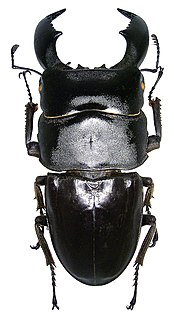
Dorcus titanus is a beetle of the family Lucanidae. It was described by Jean Baptiste Boisduval in 1835. Huang and Chen (2013) separated Serognathus from Dorcus by representing morphological characters and DNA analysis.

Odontolabis cuvera, the golden stag beetle, is a beetle of the family Lucanidae, stag beetles.

Chiasognathus grantii is a species of stag beetle found in Argentina and Chile. It is known as Darwin's beetle, Grant's stag beetle, or the Chilean stag beetle.

Cyclommatus is a genus of the family Lucanidae, also known as the stag beetle. The majority of the species from the genus Cyclommatus are located in Southeast Asia, though some species are found in China and Taiwan as well. The genus Cyclommatus also consists of three subgenera: Cyclommatus, Cyclommatinus and Cyclommatellus. Each subgenera contains 80, 24 and 3 species respectively. In total, the genus Cyclommatus consists of a total of 134 species, though more are still being discovered to this day.
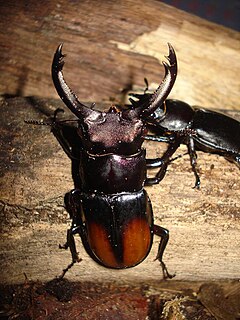
Hexarthrius parryi, the fighting giant stag beetle, is a species of large stag beetles. It belongs to the genus Hexarthrius of the tribe Lucanini. It is classified under the subfamily Lucaninae of the stag beetle family Lucanidae.

Hexarthrius is a genus of large stag beetles. They are also known as fork horned stag beetles for the shape for their mandibles It includes the following species:

Dorcus taurus is a species of beetle belonging to the family Lucanidae which was described by Johan Christian Fabricius in 1801.

Anochetus intermedius is an extinct species of ant in the subfamily Ponerinae known from two possibly Miocene fossils found on Hispaniola. A. intermedius is one of eight species in the ant genus Anochetus to have been described from fossils found in Dominican amber and is one of a number of Anochetus species found in the Greater Antilles.
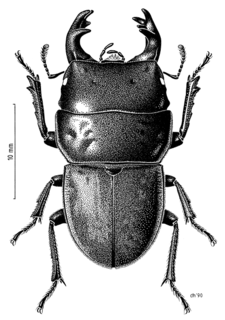
Geodorcus ithaginis, the Mokohinau stag beetle, is a large flightless species of stag beetle in the family Lucanidae. It was described by Thomas Broun in 1893 after being discovered in the Mokohinau Islands by Andreas Stewart Sandager, a lighthouse keeper on the islands. The species survives only on the small unnamed island "Stack H", in a patch of vegetation the size of a living room, and is in extreme danger of extinction.

Cyclommatus elaphus is a species of the genus Cyclommatus from Indonesia. It is also the largest species of the genus Cyclommatus and can grow up to a maximum of 109 mm from the tip of the mandibles to the end of the abdomen.

Odontomachus pseudobauri is an extinct species of ant in the subfamily Ponerinae known from one possibly Miocene fossil found on Hispaniola. O. pseudobauri is one of two species in the ant genus Odontomachus to have been described from fossils found in Dominican amber and is one of a number of Odontomachus species found in the Greater Antilles.

Prosopocoilus buddha is a species of stag beetle in the tribe Cladognathini. This Asian species is variable, with several known subspecies and widely distributed from India to Sulawesi.
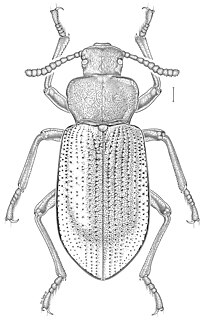
Iphthiminus serratus is a species of darkling beetles in the subfamily Tenebrioninae. Originally I. sublaevis and I. salebrosus were considered subspecies of I. serratus due to minor geographical variation, but this variation is gradual and they are now considered synonyms.

Aegus chelifer, is a species of stag beetle found in Indo-Malaya regional countries.



















